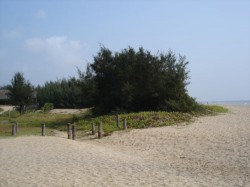Thoughts on Chennai, India
Tim Carruthers · 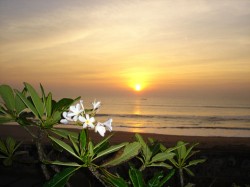
Recently, Tim Carruthers from IAN was fortunate to have the opportunity to visit Tamil Nadu in India for a LOICZ (Land Ocean Interactions of the Coastal Zone) meeting. Here are some thoughts and observations on Chennai and the surrounding country side.
Having always wanted to visit India, this was a fantastic opportunity and apart from beautiful sunrises, amazing history, and a welcome break from a long northern winter, I was struck by how friendly and engaging Indian folks are. That is not even to mention great food, a lively buzz, and the outwardly calm approach that Indians bring to every situation (admittedly, driving is a strange anomaly to that one!).
From being used to buying table salt at the supermarket and sand for cement at the hardware store, it is quite a contrast to be faced with production of these necessities, undoubtedly in the same way that people have been producing them for many centuries. Vast salt ponds near Chennai are flooded with estuarine brine and evaporated to harvest the salt—ponds are filled, evaporated, and harvested seven times with the highest quality salt on the first evaporation. After seven cycles, the sand becomes contaminated and needs to be scraped and replaced with clean sand to start the cycle again. Each evaporation takes roughly four days and continues all year, except at the height of the monsoon. Interestingly, salt is still tax-free, ever since the 1930s when protesting the British salt tax was one key component of Gandhi's non-violent protests to end British rule in India. Close by, high quality deposits of pure silica sand are sifted by teams of women into various grain sizes for different uses. Long hard hours of labor provide a couple of dollars a day, enough to buy food for the worker and possibly one or two family members.
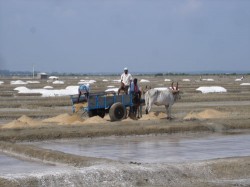
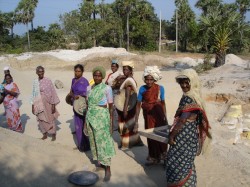
While the people are undoubtedly the most engaging and memorable aspect of visiting India, the ancient historical perspective is also eye-opening for an Australian living in the US, and therefore used to countries culturally dominated by short, western, modern histories. Around Mamallapuram there are many temples and carvings, seeping with rich history and culture. Many of these are not constructed, but carved directly into granite slopes or boulders which abound in the area, such as Arjuna's penance—a large bas-relief from the 7th century. Apparently, the first task of these stone masons was to provide entertainment for their children—perhaps to avoid being distracted?—as right below the relief is a small slide with stairs. Once again, quite the contrast to popping down to Walmart for the latest all-plastic colorful child's play extravaganza!

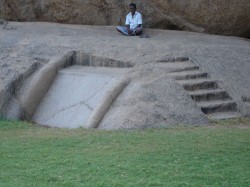
- Slide at base of Arjuna's penance
The 2004 tsunami impacted the area, with 4–10 m (13–33 ft) waves killing thousands of people in Tamil Nadu, where there are many, many fishing villages along the coast. Indeed, many locals attest that the inshore fishing has not been the same since the tsunami. New regulations make it illegal to build within 500 m (1,640 ft) of the shoreline and there has been extensive planting of trees as surge barriers along the dune line. This coastline actually has a very LOW probability of receiving a major tsunami (1 in 500+ years), but it looms large in modern global collective memory.
One final comment is that, of course, strange and random does still characterize modern India it seems. On walking through the streets of Chennai, on the one-mile bricked walking loop, people carrying water into their houses, the river in desperate need of cleaning up, random stores, and people with a smile and hello—unusual in ANY large city—was the local version of Pamplona, two bulls playing chicken with the rush hour traffic. I have to wonder where they came from or where they went? But then India, for sure, keeps one or two secrets to herself...
